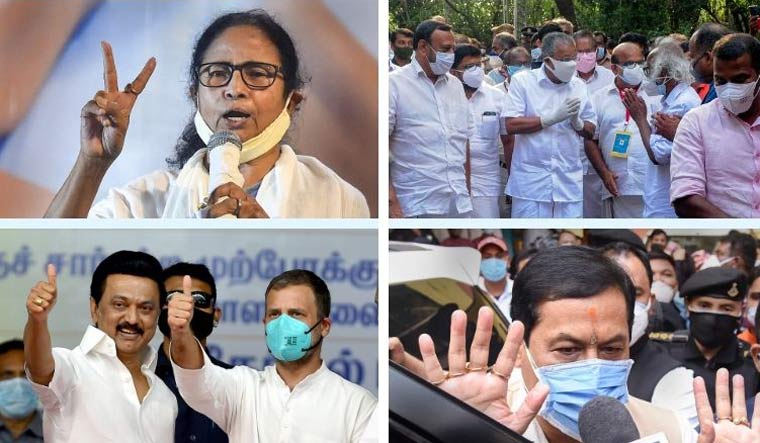The electorate has given a clear mandate in all the five states—Assam, Kerala, Puducherry, Tamil Nadu and West Bengal. The voters have not left any ground for political parties to indulge in machinations to form government. Instead, the chief ministers have been given a clear political authority to govern and provide relief during the pandemic.
These elections were crucial for the BJP and the opposition parties, given the stakes involved in them. The broad trends that have emerged from these elections suggest five key takeaways.
The CM face
The parties which had a clear and strong chief ministerial candidate found favour with the voters. It was 'Mamata Banerjee V/s all' in Bengal. The BJP didn't declare a chief ministerial candidate owing to infighting, and there wasn't one formidable regional leader who was at the forefront of the campaigns. This meant Prime Minister Narendra Modi assuming the role of key challenger against Banerjee. However, the results in the state showed that the voters were indeed looking for a local face.
Similarly, in Assam, though the BJP didn't declare a chief ministerial candidate, it had the incumbent CM, and another strong contender, Himanta Biswa Sarma. On the other side, the grand alliance did not project anyone as candidate, nor was it clear who would be the chief minister, if they were to win.
In Tamil Nadu, DMK had Stalin while the AIADMK had the incumbent Edappadi K. Palaniswami.
In Kerala, Pinarayi Vijayan was the sole chief ministerial face, while the Congress-led UDF did not project one. Though, the Congress claims that it never declares a chief ministerial candidate, even a presumptive CM face helps the party win as it happened in Rajasthan, Madhya Pradesh and Chhattisgarh where the voters had inkling as to who would head the government after the polls. In Punjab, the party had declared a CM candidate.
The BJP score
The results of the elections have made it clear that the saffron party finds the going tough when faced with a strong regional leader. The party was unable to dislodge Mamata Banerjee in Bengal, and was humiliated in Kerala where it failed to open account. Moreover, the BJP's performance since the 2019 Lok Sabha elections has been on the downslide. In 2019, it faced assembly elections in Maharashtra, Jharkhand, and Haryana among other states. The number of seats the party won has come down. In Bengal, the BJP had won over 40 per cent voteshare, but during the current elections, its voteshare has come down to 37 percent.
Besides, the voters have made it clear they may vote for Narendra Modi during the Lok Sabha elections, but keep in mind local choices and concerns when picking a CM candidate. This diversity in fact, as many observers say, is good for the democracy. Modi will have to focus on governance as the pandemic is causing immense damage in the country.
Women voters
The women voters are often ignored by the parties, but the chief ministers who have reached out to them, despite facing anti-incumbency, have been able to sail through. Bihar CM Nitish Kumar managed to save his post with the help of women voters who came out in large numbers to vote. A similar trend was being witnessed in Bengal and Kerala where the chief ministers, through their personal connect and government schemes, had benefited the women.
Opposition unity
The BJP has three formidable challengers now – Mamata Banerjee, Pinarayi Vijayan and M.K. Stalin. Banerjee has been pushing for a joint front against the BJP. After her third victory, especially the current one against the BJP's war machinery, many see her trying for that elusive grand alliance against the BJP. However, that is easier said than done. Though, the opposition voices have been rejuvenated, it is too early to say if they would be able to present a challenge to Modi.
The Central laws
As the news of the TMC's victory trickled in, there was jubilation at Delhi's borders. The farmers had campaigned against the BJP in Bengal. The BJP's loss may force the Central government to handle this simmering discontent among the community, especially when there is elections in Uttar Pradesh and Punjab next year.
The current polls results also threw up an interesting situation. The BJP had promised to implement CAA if voted to power in Bengal. It lost there. The party had put the CAA in cold storage in Assam, but it managed to retain power in that state. Do these results mean a mandate against the controversial law? Though the home ministry is yet to come with rules to govern the law, will the results mean that CAA will be relegated to the background?





